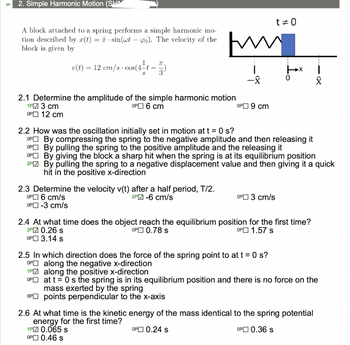Question
Only 2.6

Transcribed Image Text:9P
2. Simple Harmonic Motion (SHM
A block attached to a spring performs a simple harmonic mo-
tion described by r(t) = sin(wt-o). The velocity of the www
block is given by
v(t) = 12 cm/s · cos(4-t — 7)
-
2.1 Determine the amplitude of the simple harmonic motion
1P 3 cm
OP 6 cm
OP 12 cm
2.3 Determine the velocity v(t) after a half period, T/2.
OP 6 cm/s
2P-6 cm/s
OP-3 cm/s
OP 9 cm
OP
1PM
OP
OP
t #0
2.2 How was the oscillation initially set in motion at t = 0 s?
OP
OP
By compressing the spring to the negative amplitude and then releasing it
By pulling the spring to the positive amplitude and the releasing it
OP
By giving the block a sharp hit when the spring is at its equilibrium position
2PM By pulling the spring to a negative displacement value and then giving it a quick
hit in the positive x-direction
OP 3 cm/s
2.5 In which direction does the force of the spring point to at t = 0 s?
along the negative x-direction
0
2.4 At what time does the object reach the equilibrium position for the first time?
OP 0.78 s
OP 1.57 s
2P 0.26 s
OP 3.14 s
Î
along the positive x-direction
at t = 0s the spring is in its equilibrium position and there is no force on the
mass exerted by the spring
points perpendicular to the x-axis
2.6 At what time is the kinetic energy of the mass identical to the spring potential
energy for the first time?
1P 0.065 s
OP 0.24 s
OP 0.36 s
OP
0.46 s
Expert Solution
This question has been solved!
Explore an expertly crafted, step-by-step solution for a thorough understanding of key concepts.
Step by stepSolved in 5 steps

Knowledge Booster
Similar questions
- 3. Solve to the significant number of digits (a) 25.3456 + 888.010 + 53.11 +7-1.0 (b) (45.805*2.00)/5.0 + 0.1arrow_forward13. A railroad car of mass 2.50 X 104 kg is moving with a speed of 4.00 m/s. It collides and couples with three other coupled railroad cars, each of the same mass as the single car and mov- ing in the same direction with an initial speed of 2.00 m/s. (a) What is the speed of the four cars after the collision? (b) What is the decrease in mechanical energy in the collision?arrow_forwardThe bottom says "H = 222 * (1)22 × -10 = 24.2 m". I dont understand this calculation and how the answer is 24.2 marrow_forward
arrow_back_ios
SEE MORE QUESTIONS
arrow_forward_ios